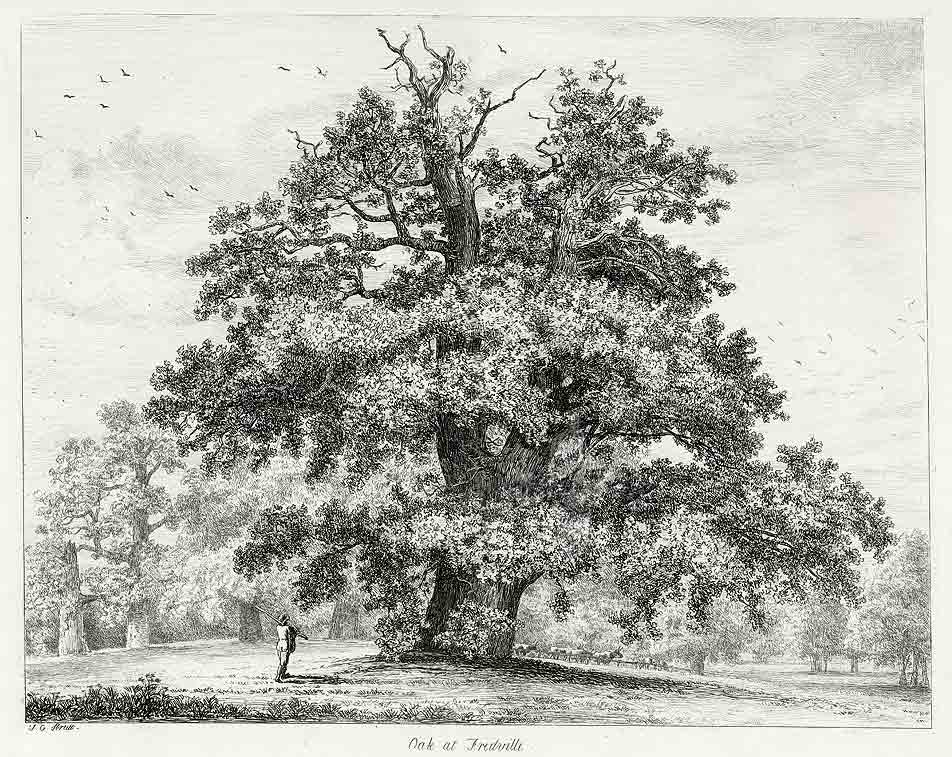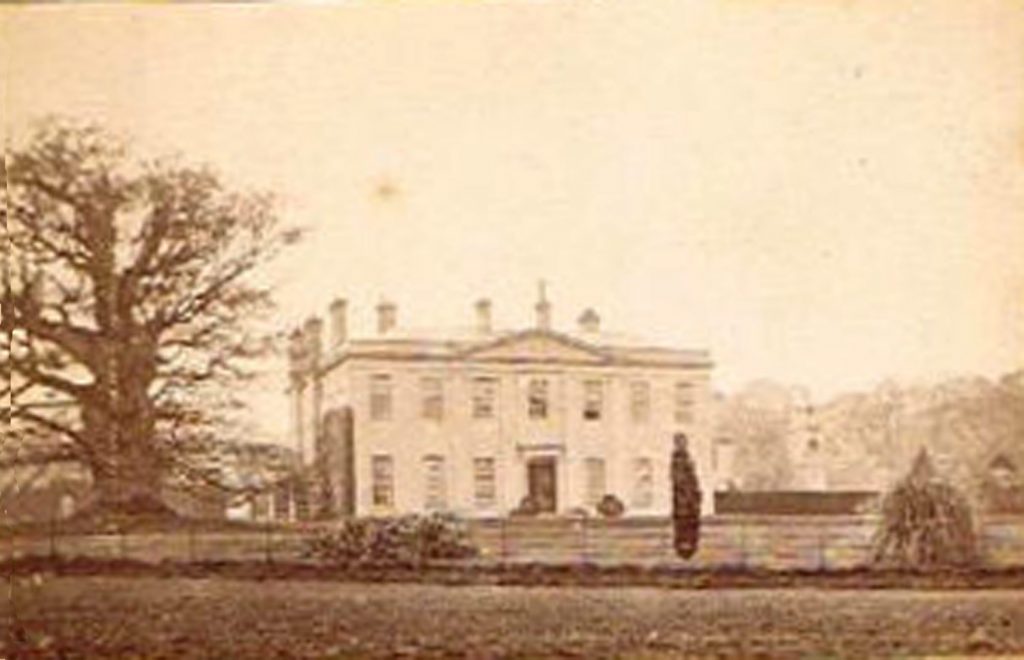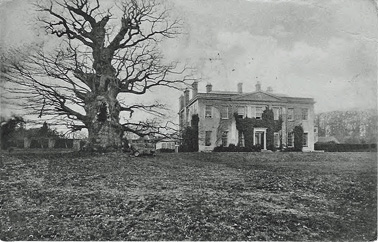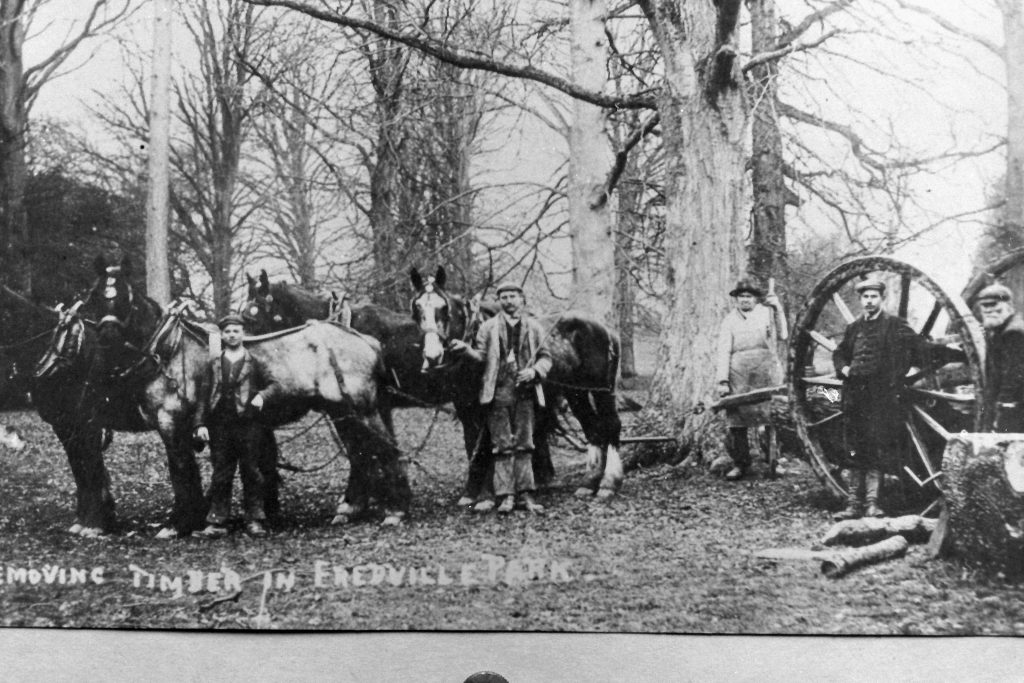Please note: the Fredville Oaks are on private property with no rights of public access. Please do not go knocking on the doors of the nearby cottages regarding access as they are occupied by residents with no connection to the land-owner.
Enquiries regarding the Fredville Oaks should be made in writing to:
Mr. J. Plumptre,
Little Fredville,
Frogham,
Nonington,
Kent.
CT15 4JF.
Communications sent by email will not be acknowledged.
The Fredville Oaks
Fredville Park has been renowned since the late 18th century for magnificent trees, especially its oaks and chestnuts. William Hasted wrote in his :‘History and topographical survey of the County of Kent’, in the late 1790’s: “At a small distance from the front of Fredvile-house, stands the remarkable large oak tree, usually known by the name of the Fredville oak. It measures twenty-seven feet round in the girth, and is about thirty feet in height; and though it must have existed for many centuries, yet it looks healthy and thriving, and has a most majestic and venerable appearance”.
The journal “Annals of agriculture and other useful arts” carried a series of reports on visits to East Kent, a visit to Fredville on July 6, 1793, was described as follows:
“Call on John Plumtree, Esq. of Fredville, who very politely shews us his famous oak, called Majesty -, measure this tree; 4 feet from the ground the circumference is 31 feet ; it is supposed to contain from 36 to 42 tons of timber. Two branches separated from this tree about four years ago, in a calm day, which contained three tons of timber. Another oak, called Beauty, 14 tons of timber ; girt, 4 feet from the ground, 16 feet 4 inches, is 63 feet high, perfectly straight, and a beauty indeed !—From hence to Denne-Hill (in Womenswold parish).—Much corn, very poor, and full of weeds. See a South Down flock of very inferior kind. Return to Betshanger. Day’s ride 14 miles”.



John Evans wrote a decade or so later in his travelogue in “The Juvenil Tourist: Or Excussion Through Various Parts of the Island of Great Britain” published in 1805:
“Not far from Waldershare is Fredville, the seat of John Plumptree, Esq.—in the park belonging to which are oak-trees, the most extraordinary for height and size in the kingdom. They are distinguished, by appropriate names; but the most remarkable of them are those called ”Majesty”, “Stately”, and ”Beauty”.—”Beauty” is sixty-three feet from the ground, whilst the uniformity of its branches, and the regularity of its bark, are beautiful beyond conception. The circumference of this tree, five feet from the ground, is fifteen feet nine inches—its solid contents, bark not included, twelve ton twenty-five feet.—”Stately” at four feet from the ground, measures in circumference eighteen feet— and its solid contents twelve ton thirty-three feet one inch, bark not included.
“But “Majesty”, the most wonderful of all these trees, has, eight feet from the ground, a circumference of twenty-eight feet four inches—and at twenty-eight feet from the ground fifteen feet six inches. It has one arm which contains sixty-eight feet eleven inches— another sixty-four feet two inches—a third, sixty feet nine inches, and several others of nearly equal dimensions. The total contents of this huge bulk of timber are thirty-six tons twenty-eight feet four inches, bark not included”.












A few years later Jacob George Strutt’s “Sylva britannica : or, Portraits of forest trees, distinguished for their antiquity, magnitude, or beauty or, Portraits of forest trees, Drawn from nature” published in 1830 recorded , “Nearly in front of the family mansion of John Plumtre, Esq., in his park at Fredville, in the parish of Nonnington, Kent, is a group of oaks known by the names of Majesty, Stately, and Beauty. Seldom are three trees so different from each other in individual character, and so interest- ing altogether, to be found in such near proximity.
“Majesty, which, as its name denotes, is the largest, is somewhat more than twenty-eight feet in circumference, at eight feet from the ground, and contains above fourteen hundred feet of timber. Stately, the next in point of size, is a noble specimen of the tall oak ; the stem going up straight and clean to the height of seventy feet. The girth, at four feet from the ground, is eighteen feet ; and it contains about five hundred feet of timber. Beauty, at an equal height, is sixteen feet in circumference, and its solid contents are nearly the same. Altogether these three graces of the forest form a group immediately within sight of the house, which, for magnificence and beauty, is not perhaps to be equalled by any other of the same nature ; awakening in the mind of the spectator the most agreeable associations of the freedom and grandeur of woodland scenery, with the security and refinements of cultivated life”.
In 1890 £.100.00 was offered for “Stately” to be felled and used as timber, a huge amount for a tree at this time an agricultural labourer would have earned about £.25 to £.30 a year, but the offer was fortunately declined.
Lillian Boys Behrens wrote in “Under thirty-seven kings; legends & records of the family of Boys“, published in 1926, that Fredville House had once stood at the end of a long avenue of trees but that at the time of writing only a few oaks remained. She recorded that two of the largest oaks near to the house were known to have been flourishing in 1554 and were then known as “The Ancient Bear’ and ‘King Fredville Oak’ . The later may have been an earlier name for “Majesty”, and “The Ancient Bear’ for either “Beauty” or “Stately”., unfortunately no accurate records of the trees seem to exist from these earlier times. In her book Mrs. Boys Behrens also offered the opinion that Fredville’s gardens also contained the finest magnolia tree in England.
“Majesty” had a large bough broken off on its east side in 1924, and has within the last year or so undergone some additional minor surgery. “Beauty”, “Stately” and another old oak tree known as “Staghorn” are still standing although a bit worse for wear. The Guinness Book of Records “Majesty”’ as the largest surviving maiden oak in the United Kingdom, and estimates of “Majesty’s” age vary from 450 to 1,000 years old. If ‘King Fredville Oak’ was the previous name for “Majestie” then this would indicate that the tree was of considerable age in 1554 and make the higher estimate the most likely.
++++++
Please note: the Fredville Oaks are on private property with no rights of public access. Please do not go knocking on the doors of the nearby cottages regarding access as they are occupied by residents with no connection to the land-owner.
Enquiries regarding the Fredville Oaks should be made in writing to:
Mr. J. Plumptre,
Little Fredville,
Frogham,
Nonington,
Kent.
CT15 4JF.
Communications sent by email will not be acknowledged.
The “Step Tree” & other chestnuts
In the 1930’s Dr. Hardman, a noted East Kent historian recorded the memories of Richard Jarvis Arnold of of life in Nonington in the 1880’s & 90’s. Mr. Arnold, a blacksmith born in Nonington but who later lived and worked in Walmer, recollected: “The trees of Fredville Park were well known. In addition to the old oak there were some large chestnuts. One was called the ‘Step Tree’ and had some steps affixed to it. In the upper part of the trunk and branches 12 or 20 people could sit”.
It was said that members of the Plumptre family often had tea on the platform in the “Step Tree” in the years before the Great War. The chestnut tree is still there but is now unfortunately showing its age, it is one of the few surviving sweet chestnut trees that once made up two avenues leading from Fredville House into the park.
After the new Fredville House was built by Margaretta Bridges, the sister of Sir Brooke Bridges of Goodnestone, in the 1740’s the farmland in front of the eastward facing house was landscaped after the fashion of the times. Two double rows of Spanish chestnut trees, also known as sweet chestnuts, were planted to form avenues leading from the new mansion into the landscaped parkland. The avenues ran eastward down into the parkland from the south [Frogham] and north [Nonington] ends of the mansion. Anyone then standing in the front door or looking through one of the front windows would have had an uninterrupted view down the avenue towards the top of the park.
John Evans in “The Juvenil Tourist: Or Excussion Through Various Parts of the Island of Great Britain“, published in 1805, said of the house “Fredville is neat and spacious—it has, together with the house, within these few years been not only enlarged but improved with taste and judgment. The Mansion, standing on a rising ground, has a handsome brick front, supported by six columns of the Corinthian order—the drawing-room- is truly elegant, and the library contains several thousand volumes, selected from the most approved ancient and modern authors. From the front of the house to the south, Barson [Barfreston] mills wave their swifts above the plantations, and on the north-west Nunnington mills [the Easole corn mill & feed mills] form a correspondent prospect. The swing suspended from the high branch of a towering oak—the rabbits skipping from hole to hole, formed among the fibres of the trees, and a rising family of hearty children seen amidst their innocent gambols constitute at once a piece of rural and delightful scenery. At the south-west end of the Mansion the Green-house has a pretty effect, displaying the skill of the Botanist whilst the industrious bees are observed conveying their plundered stores into glasses fixed within the windows of their abode, which in its turn is plundered to enrich the owner’s table! The gardens behind the house are encircled with a shrubbery, along which a green walk, defended by a light post and rail, presents us with a view of the surrounding country. The woods on the south [Broom Hill and Oxney Woods, the first is under the colliery tip, the view of the second is now obscured by the same tip],—the distant telegraph on the west [the Admiralty telegraph at Womenswold] , and the Isle of Thanet with Ramsgate harbour, &c. on the north-east, tend to enrich and diversify the prospect. The Bowling Green also hid among the trees—the laurelled-covered Ice-house, the sweet briar hedge and the weeping ash trees enhance the sensations of delight arising from the contemplation of this spot. In a word, should any thing be thought wanting, a stream of water would complete the situation”.














The programme for an excursion by Kent Archaeological Society to Nonington in September, 1936, noted that: ‘The well known ‘Majesty Oak’ is close to the terrace (of the house); it is 38 ½ fee in girth (4 ½ feet above the ground) and may be 1,000 years old. At a little distance is the chestnut avenue in which the ‘Step’ tree and two others are notable. Further in the park (near Sheerway or Shereway Gate) is the famous horn beam, which has a ‘spread’ of over 100 feet; and perhaps this is the most notable of all. It is possibly 500 years old’.
It was reputed that a company of soldiers could take shelter underneath the hornbeam’s spreading branches, possibly this was discovered when the East Kent Rifle Volunteers mustered in Fredville Park in 1872. Unfortunately the horn beam is long gone, and I can find no pictorial or written details concerning it.


Have only recently discovered this lovely park, such an intere-
sting history
Had a fascinating time at Fredville seeing the chestnuts and Majesty oak. Life enhancing to see and touch such ancient massive trees.